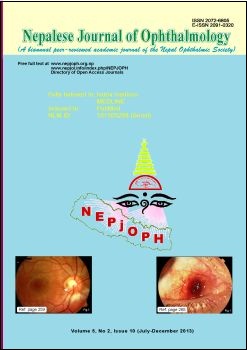Prospective comparison of chilled versus room temperature saline irrigation in alcohol-assisted photorefractive keratectomy
DOI:
https://doi.org/10.3126/nepjoph.v5i2.8706Keywords:
photorefractive keratectomy, PRK, chilled saline, balanced salt solution, refractive surgeryAbstract
Introduction: Chilled saline is commonly used to irrigate the ocular surface after photorefractive keratectomy (PRK) and is often considered by the patients to be uncomfortable. Room temperature (non-chilled) saline may be a safe and less painful alternative.
Objectives: To compare pain and visual outcomes after irrigating the ocular surface with chilled saline versus room temperature saline in alcohol assisted PRK.
Materials and methods: In this prospective, single-masked, randomized, contralateral eye study, myopic eyes were treated with PRK. Immediately after laser ablation one eye was irrigated with chilled saline and the other with non-chilled saline. Primary outcomes measured were pain, haze, uncorrected (UCVA) and best-corrected (BCVA) visual acuities, and manifest refraction.
Results: Each group comprised of 40 eyes. There was no significant difference in pain between the groups at any point during five days after surgery. At 6 months the mean UCVA was -0.08 logMAR ± .077 [SD] (20/17) and -0.07 ± .074 logMAR (20/17) in the chilled and non-chilled groups respectively (p =.35). Both groups achieved 95% UCVA of 20/20 or better. The manifest refraction spherical equivalent (MRSE) was -0.05 ± 0.21 D and -0.025 ± 0.27 D respectively (p = .79). There were no lines lost of BCVA and no haze observed. Similar outcomes were observed with regard to pain and vision in both groups.
Conclusion: The use of room temperature saline irrigation during PRK appears to be safe and effective.
Nepal J Ophthalmol 2013; 5(10): 154-160
Downloads
Downloads
Published
How to Cite
Issue
Section
License
This license enables reusers to copy and distribute the material in any medium or format in unadapted form only, for noncommercial purposes only, and only so long as attribution is given to the creator.




